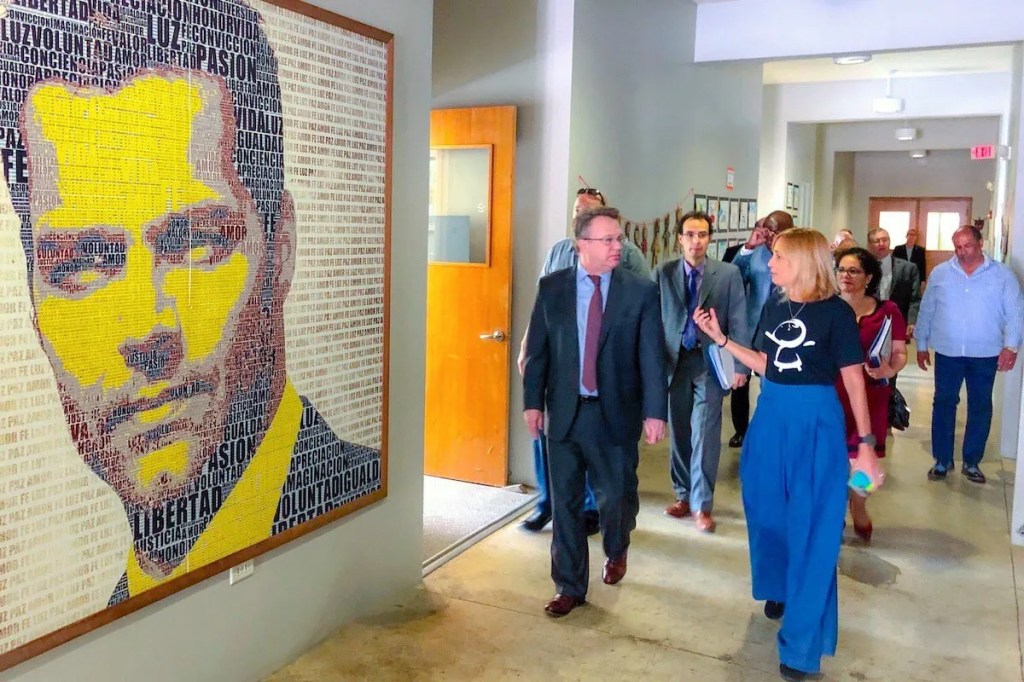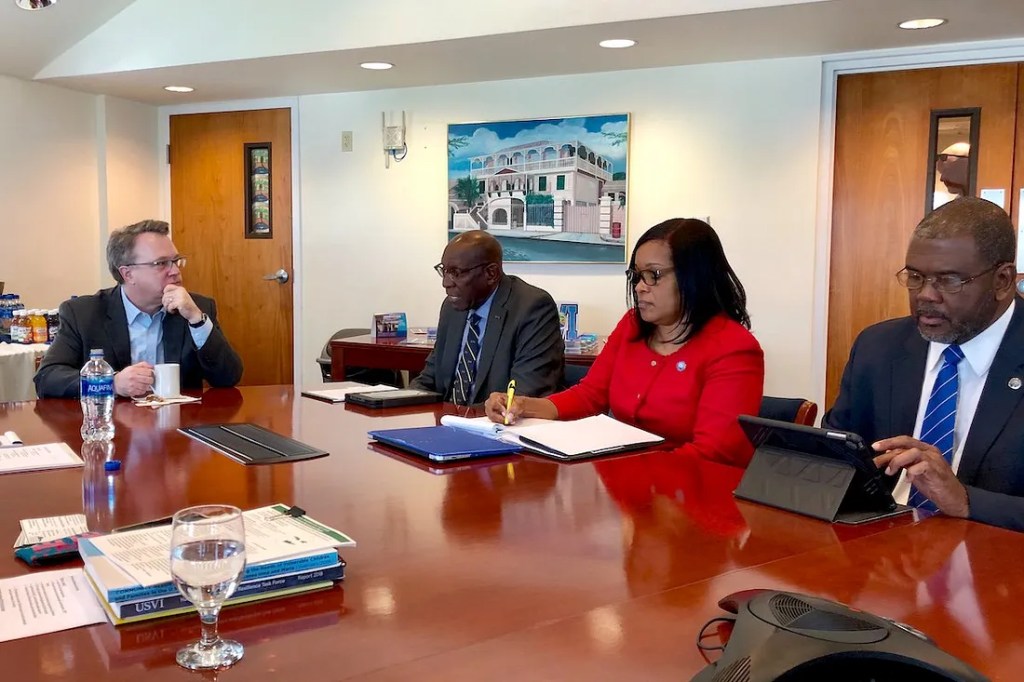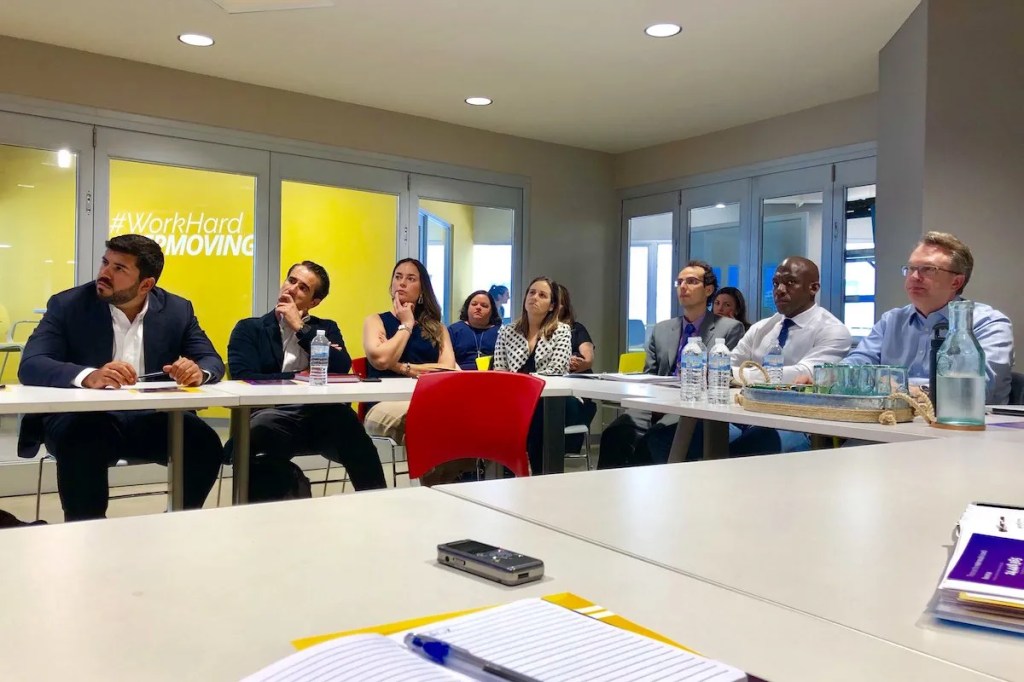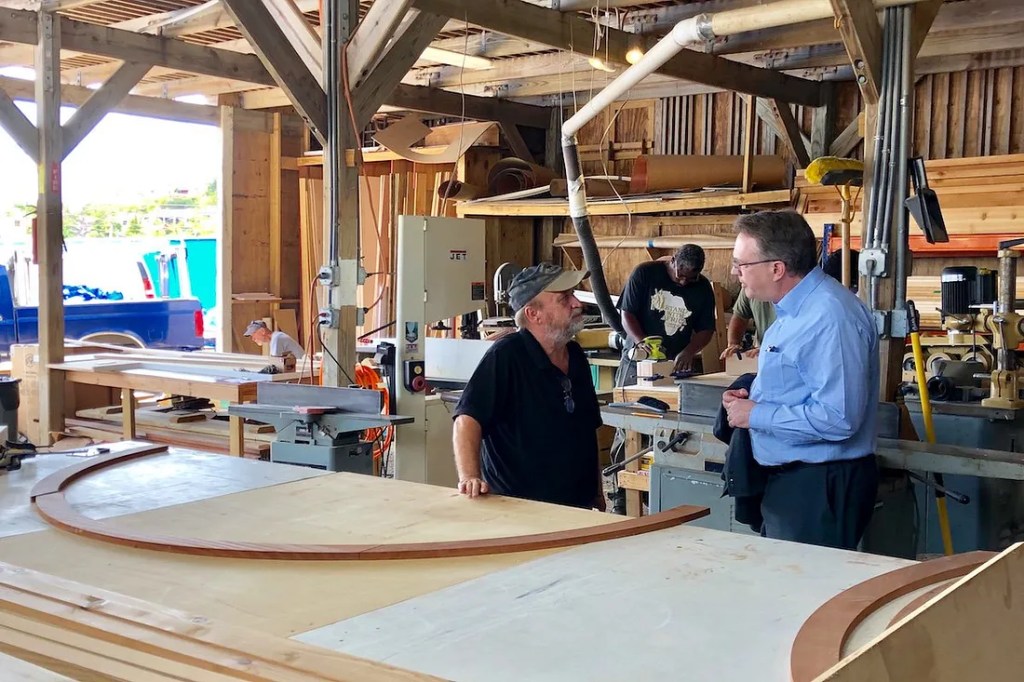
New York Fed President John C. Williams visited Puerto Rico and the U.S. Virgin Islands in late March, where he met with elected officials and community and business leaders to gain a deeper understanding of current economic conditions and the continuing recovery efforts in the aftermath of Hurricanes Irma and Maria. The hurricanes battered the region in quick succession in late 2017, and the islands still have a long road to recovery. This was President Williams’ first regional visit of the year, and topics in focus included ongoing hurricane recovery efforts, collaboration among organizations, a burgeoning entrepreneurship and start-up ecosystem, and the numerous challenges small businesses face.
This trip builds on the work the New York Fed has been doing to support Puerto Rico and the U.S. Virgin Islands as their economies recover (we last visited the islands in March 2018; see our posts from last year on the impact of the hurricanes and future paths for the economy).
Hurricane Recovery and Revitalization
Residents of Puerto Rico and the U.S. Virgin Islands feel a sense of urgency as they look to the future, with federal and private funds expected to continue to flow into the region over the next few years. Each region has unique circumstances and economic challenges, and each now has a window of opportunity to enact reforms.
Puerto Rico continues to contend with issues that predate the hurricanes — including an ongoing fiscal crisis, declining population, an outdated electrical grid, and an underperforming tourism sector — but local stakeholders highlighted a few initiatives and organizations that are working to boost economic growth over the long term. Invest Puerto Rico is a nonprofit focused on attracting new businesses and investment, and the Destination Marketing Organization seeks to transform the island into a hub for leisure and business travel. The Convention Center District includes a new entertainment destination known as District Live, which aims to draw greater numbers of conventions, group meetings, and conferences. And the Public-Private Partnerships Authority, a government-owned corporation, is moving forward with a series of airport privatization projects.
Meanwhile, local leaders in the U.S. Virgin Islands are still grappling with a significantly reduced stock of hotel rooms in an economy that relies heavily on the tourism sector. Officials estimate that about 70% of hotel rooms are back on line, but it could be two to three years before the islands reach pre-hurricane levels of hotel room inventory, and they expect to lose tourism market share to other Caribbean destinations while rebuilding efforts are underway. A related challenge is rising housing costs, as local residents compete with a flood of recovery contractors and personnel for housing. Moreover, while the rise of short-term rentals provides needed accommodations for visitors, these rentals reduce the supply of long-term housing for local residents.

We also heard concerns in the U.S. Virgin Islands about opportunities for residents and businesses to benefit from the recovery and rebuilding. In St. Croix, there is a preference among members of the community for smaller-scale development projects such as inns and bed and breakfast establishments, as opposed to the large-scale resorts found in St. Thomas or St. John. Advocates said they welcome innovation and efficiency, but that does not necessarily entail large-scale investment, and they are hopeful that having local businesses and workers fully involved in the rebuilding will lead to a sustained recovery.
Small Business
In Puerto Rico, small business owners and entrepreneurs highlighted access to capital as one of the biggest inhibitors to growth. They said it is difficult to make inroads to investor networks on the mainland, especially those centered in Silicon Valley. Some firms highlighted the need to leave Puerto Rico to access equity financing to reach the next stage of growth.

Small business owners and entrepreneurs gave high marks to the Puerto Rico Science, Technology, and Research Trust for its efforts to connect the island’s small business ecosystem through Parallel18, a small business incubator, and Colmena 66, a referral network that links small business owners to resource partners. However, because the local government is often viewed as slow to issue permits and licenses, stakeholders expressed a desire for an office dedicated to fostering entrepreneurship and innovation that would help streamline processes and serve as a link between universities and the private sector to facilitate technology transfers.
In the U.S. Virgin Islands, businesses still face numerous challenges in the aftermath of the hurricane. While tourism declined after the 2017 storms, it has actually been several decades since the construction of a new hotel on St. Thomas. When small businesses and construction projects can’t get funding, it is difficult to attract new businesses to the island.
Business owners on St. Thomas also reported difficulty in maintaining their workforces because some employees have taken short-term recovery jobs with higher wages. While the economy is highly tied to tourism, restaurateurs and operators of entertainment establishments must increasingly compete with cruise ships that feature revamped entertainment and dining options.
Grassroots Efforts
During a visit to Loíza, a Puerto Rican municipality east of San Juan, President Williams visited an institution that has collaborated with local residents to take a holistic approach to hurricane recovery. Centro Tau, a project of the Ricky Martin Foundation, has helped rebuild housing, create skills training opportunities, reduce youth violence, and provide economic opportunities for local residents.

After a tour of the facility, President Williams met with Centro Tau’s leadership and Loíza Mayor Julia M. Nazario to hear firsthand accounts of the impact of the hurricane and the ensuing grassroots recovery efforts. In the aftermath of the hurricane, the center served as a haven for the community and helped to raise funds for recovery. Centro Tau also partnered with a community development housing organization to rebuild a number of homes in the area. Loíza is home to the island’s Afro-Puerto Rican cultural heritage, including food, music, art, and dance. Mayor Nazario is seeking to promote these unique cultural attributes to attract tourists and create entrepreneurship opportunities for residents.
In the U.S. Virgin Islands, President Williams toured the facilities of My Brother’s Workshop, an organization that helps at-risk youth by offering training programs in carpentry, electrical work, plumbing, construction, and the culinary arts. The organization has created a training environment that simulates real world work settings, and it provides associated counseling and support to program participants. In the immediate aftermath of the hurricanes, My Brother’s Workshop offered meals for the community through a program at the Back Street Café, its bakery in downtown St. Thomas, and mobilized its woodshop to help residents repair damaged homes.

At the workshop, we saw machines for precision cutting and engraving of wood, plastics, and metals, on which participants in the program train for skills that are transferable to jobs in the manufacturing industry.
See Also
President Williams met with leaders in business, community development, and government throughout Manhattan last week — we’ll have a report on the day’s themes in the weeks ahead. The next regional visit will be to Albany and the Hudson Valley in July. For more information about the purpose of the New York Fed’s regional visits and what we heard on earlier trips, see our posts on Brooklyn, Buffalo and Niagara Falls, and the Bronx.
This article was originally published by the New York Fed on Medium.
The views expressed in this article are those of the contributing authors and do not necessarily reflect the position of the New York Fed or the Federal Reserve System.










